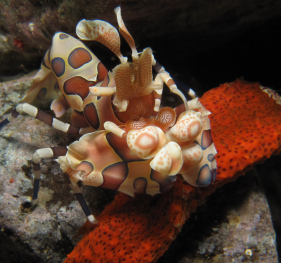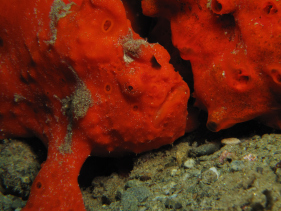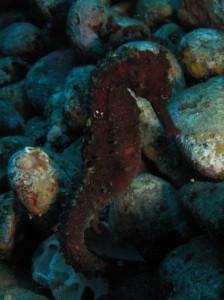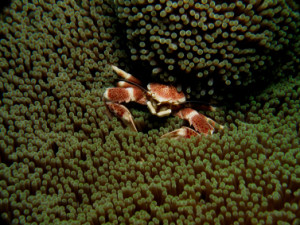News
Creatures of the Muck

 Muck diving. “Le” muck diving. There is no pretty way to say muck diving even if you are French. In fact when you do muck dive for the first time and look out over a silty, sandy slope, or a pile of coral rubble, it seems that a hopeless hour underwater searching for some form of life, including your dive buddies, is ahead. I was especially worried about unfairly judging muck diving at Maluku Divers in Ambon because my trip there immediately followed a boat trip through Raja Ampat which is so full of color and life everywhere. But with a beautiful Balinese meal sitting in front of me at the end of the first day of diving on Ambon, my thoughts were that, perhaps all of the previous 15 days of travel, including three international flights through four countries, two domestic flights, and a liveaboard trip of twelve days, was just to arrive at Maluku Divers on Ambon.
Muck diving. “Le” muck diving. There is no pretty way to say muck diving even if you are French. In fact when you do muck dive for the first time and look out over a silty, sandy slope, or a pile of coral rubble, it seems that a hopeless hour underwater searching for some form of life, including your dive buddies, is ahead. I was especially worried about unfairly judging muck diving at Maluku Divers in Ambon because my trip there immediately followed a boat trip through Raja Ampat which is so full of color and life everywhere. But with a beautiful Balinese meal sitting in front of me at the end of the first day of diving on Ambon, my thoughts were that, perhaps all of the previous 15 days of travel, including three international flights through four countries, two domestic flights, and a liveaboard trip of twelve days, was just to arrive at Maluku Divers on Ambon.
Although we took one of the longest, but most scenic, ways to get to Ambon, once we arrived there, our traveling was over. Our first dive at Laha I, along the southern coast of Ambon Bay, was reported to be an absurdly long interval away from the resort when in fact it took less than five minutes – barely enough time to be introduced to Jamal, our experienced dive guide from Lembeh, Mo our boat driver, and Hafez, a young Indonesian king who helped us with our equipment on the day boat. Topside, this dive site happens to be a small but active wharf area where people seem to both live and work on their boats. The children are especially intrigued by the foreign divers. They wonder why we use our money to travel so far just to see the fish right under their boats.
 We did a backward roll into the warm water and swam to a pile of rubble directly under the boats. It was noon so I was completely surprised when it was a mandarin fish colony that we were on a mission to observe. My previous encounters with mandarin fish were to watch them having sex at 6:30 in the evening, but they were also busy scampering about at noon, just ignorant of the opposite sex and yet brilliant against their colorless home. I was so focused on getting that perfect photo of a mandarin fish that I almost missed just how many other creatures inhabited this rather small rubble complex. Banded pipefish were just hanging in the water, and very long white antennae revealed the location of the largest banded coral shrimp that I had ever seen. One of the oddest-looking fish, an estuarine stonefish, was lying there like a sunken shipwreck. With the exception of the stonefish that seemed cemented into this habitat, I found it difficult to understand that out of the entire ocean these creatures chose this noisy, close to shore site, and yet they live here together at least during daylight, harmoniously. These were my first 30 minutes in Ambon.
We did a backward roll into the warm water and swam to a pile of rubble directly under the boats. It was noon so I was completely surprised when it was a mandarin fish colony that we were on a mission to observe. My previous encounters with mandarin fish were to watch them having sex at 6:30 in the evening, but they were also busy scampering about at noon, just ignorant of the opposite sex and yet brilliant against their colorless home. I was so focused on getting that perfect photo of a mandarin fish that I almost missed just how many other creatures inhabited this rather small rubble complex. Banded pipefish were just hanging in the water, and very long white antennae revealed the location of the largest banded coral shrimp that I had ever seen. One of the oddest-looking fish, an estuarine stonefish, was lying there like a sunken shipwreck. With the exception of the stonefish that seemed cemented into this habitat, I found it difficult to understand that out of the entire ocean these creatures chose this noisy, close to shore site, and yet they live here together at least during daylight, harmoniously. These were my first 30 minutes in Ambon.
The psychedelic frogfish’s coloring was also a bit of a mystery to me. It is usually obvious why a frogfish looks as it does; generally I am not sure that I have actually seen one when I have seen it because they imitate their habitat so well. Although the overall color of the psychedelic frogfish allows it to blend in with the sand of Ambon, there are vibrant white lines that extend radially from its eyes and then swirl around over the main part of its body. It was not until I read about this fish, where these patterns were shown to parallel those from certain hard corals, that I could begin to see how the fish evolved to mimic its environment. However, the lines also have a sort of hypnotizing affect on the viewer, and perhaps have a dual purpose in distracting as well any prey so that it loses concentration for a moment.
 The dives in Ambon rarely went below twenty meters. Only once did I find myself at twenty-five meters and that was to watch a flamboyant cuttlefish that we had inadvertently chased to this depth. Most dives occurred on this same coast, just different sections of it. Even though the landscape was somewhat similar overall, sloping sandy, I was starting to feel that there were different neighborhoods. The Laha dives were where the harlequin and bumblebee shrimp, pipefish, and assorted frogfish lived in the rubble and the sand. Further west, the landscape becomes more covered with corals and especially crinoids. Here there is also a jetty, Air Manis Jetty, where a different lifestyle is in development. There is quite a bit of human refuse where eels and giant banded coral shrimp could find a home. The crinoids here have space to move about the sand like ladies in 17th century ball gowns and were sometimes escorted by a matching ornate or long nosed ghost pipefish. Octopi displayed themselves openly in daylight, and fat nudibranchs were busy chewing the sponges that covered the pilings of the pier.
The dives in Ambon rarely went below twenty meters. Only once did I find myself at twenty-five meters and that was to watch a flamboyant cuttlefish that we had inadvertently chased to this depth. Most dives occurred on this same coast, just different sections of it. Even though the landscape was somewhat similar overall, sloping sandy, I was starting to feel that there were different neighborhoods. The Laha dives were where the harlequin and bumblebee shrimp, pipefish, and assorted frogfish lived in the rubble and the sand. Further west, the landscape becomes more covered with corals and especially crinoids. Here there is also a jetty, Air Manis Jetty, where a different lifestyle is in development. There is quite a bit of human refuse where eels and giant banded coral shrimp could find a home. The crinoids here have space to move about the sand like ladies in 17th century ball gowns and were sometimes escorted by a matching ornate or long nosed ghost pipefish. Octopi displayed themselves openly in daylight, and fat nudibranchs were busy chewing the sponges that covered the pilings of the pier.
 Each hour underwater at Ambon went by like lightening for me. I am not sure what kind of rating system one can apply to diving in Ambon. A star rating system does not seem accurate because it conjures up more typical images like corals and blue water and big animals and whether there is current or not. Things are not swimming around much and if they do have fins they can also have legs attached to creep around, and sometimes your photos of an odd creature inadvertently advertise Coke. I am a scientist, and I cannot help but think of evolution when I am under the water. All sorts of ideas pop into my head, like what exactly was evolution thinking, and how genetically different am I really than the rhinopias scorpionfish? To me it seems that Ambon is a collection of evolution’s experiments or abandoned ones in addition to the usual animals, and perhaps a rating system should correlate to remarkable skills of evolution at work here and your confidence level as a diver when you leave.
Each hour underwater at Ambon went by like lightening for me. I am not sure what kind of rating system one can apply to diving in Ambon. A star rating system does not seem accurate because it conjures up more typical images like corals and blue water and big animals and whether there is current or not. Things are not swimming around much and if they do have fins they can also have legs attached to creep around, and sometimes your photos of an odd creature inadvertently advertise Coke. I am a scientist, and I cannot help but think of evolution when I am under the water. All sorts of ideas pop into my head, like what exactly was evolution thinking, and how genetically different am I really than the rhinopias scorpionfish? To me it seems that Ambon is a collection of evolution’s experiments or abandoned ones in addition to the usual animals, and perhaps a rating system should correlate to remarkable skills of evolution at work here and your confidence level as a diver when you leave.
Gear News
Introducing the TR-80, IR-50 and CS-30 Regulators from DYNAMICNORD

Whether you are a beginner or a professional diver – with the three new main regulators from DYNAMICNORD, everyone will find their favourite regulator. They all look super stylish.
Excellent performance with the TR-80
Quality and performance are the be-all and end-all for regulators. It is not for nothing that the TR stands for Tec Reg. The innovative design of the TR-80 guarantees absolute reliability – even in ice-cold waters.

Perfect breathing effort at 0.8 J/l / certified for diving in waters below 10 degrees / structural design made of solid brass for best cold protection / membrane-compensated design with dry seal of the first stage / reduced exhalation effort thanks to optimized exhalation membrane and bubble deflector / adjustable Venturi (dive/predive) and adjustment knob for individual inhalation comfort / innovative design of the front cover prevents free-flow in strong currents or when diving with scooters / design made of sandblasted brass, matt chrome finish / 2 HP and 4 LP outlets / mouthpiece made of high-quality, anti-allergic silicone for maximum comfort.


Amazing underwater adventures with the IR-50
The IR-50 is the top regulator for advanced and experienced divers. Natural breathing is the essence of this regulator.

Ideal breathing effort at 0.8 J/l /certified for diving in waters below 10 degrees / compensated membrane / adjustable venturi (dive/predive) and adjustment knob for individual inhalation comfort/ outlet valve and deflector for minimum exhalation effort and reduction of bubbles on the face / design made of sandblasted brass, matt chrome finish / 2 HP and 4 NP outlets / mouthpiece made of high-quality, anti-allergic silicone for maximum comfort.


The Workhorse – our CS-30
For diving centres and diving beginners – the workhorse stands for strong construction, reliability and robustness. Perfect for your training.

Optimal breathing effort at 0.8 J/l /recommended for diving in waters above 10 degrees / non-compensated piston / adjustable venturi (dive/predive) / outlet valve and deflector for minimum exhalation effort and reduction of bubbles on the face / design made of sandblasted brass, matt chrome finish / 1 HP and 3 NP outlets / mouthpiece made of high-quality, anti-allergic silicone for maximum comfort.


Octopus OP-30
The OP-30 is the ideal addition to all DYNAMICNORD regulators. It is identical in construction to the CS-30.

The TR-80, IR-50, CS-30 (DIN & INT) regulators and the Octopus OP-30 are available from DYNAMICNORD dealers and in the online store.
DYNAMICNORD – Your Outdoor Companion.
Marine Life & Conservation
Paul Watson Released as Denmark Blocks Japan’s Extradition Bid

Renowned anti-whaling activist Paul Watson has been released from custody in Greenland after spending five months in detention. Denmark’s Justice Ministry rejected Japan’s request for his extradition, citing insufficient guarantees that his time already served in custody would be credited against any potential sentence.
The 74-year-old Canadian-American was arrested on July 21 in Nuuk, Greenland’s capital, when his ship docked to refuel. His arrest was based on a 2012 Japanese warrant related to a 2010 encounter in Antarctic waters. Japan alleged Watson obstructed operations and caused damage to a whaling research ship during efforts to disrupt illegal whaling. Watson has consistently denied these claims, maintaining his commitment to marine conservation.
Denmark, which oversees extradition matters for Greenland, concluded that while the legal conditions for extradition were met, the lack of assurances from Japan regarding time-served credit made extradition untenable.
In a video shared by his foundation, Watson expressed gratitude and relief, saying, “After five months, it’s good to be out… and good to know they’re not sending me to Japan.” He added that the most difficult part of his time in custody was being separated from his two young sons.
Watson is a pioneering figure in marine conservation, known for founding the Captain Paul Watson Foundation in 2022 after decades of activism with the Sea Shepherd Conservation Society. His bold efforts to defend marine life have earned him widespread support, including from celebrities and conservationists. His work has also been featured in the acclaimed reality TV series Whale Wars.
Watson’s lawyer, Jonas Christoffersen, praised the decision, stating, “We are happy and relieved that Paul Watson is now free.” He added that Watson is eager to reunite with his family and continue his vital work.
The arrest occurred while Watson’s vessel, the M/Y John Paul DeJoria, was en route to the North Pacific with a team of 26 volunteers to intercept a Japanese whaling ship. His foundation described the arrest as politically motivated and emphasized that Watson’s actions were focused on ending illegal whaling practices.
Japan resumed commercial whaling in 2019 after leaving the International Whaling Commission, asserting that whale meat is a cultural tradition. Conservationists, however, continue to challenge these practices, highlighting their impact on marine ecosystems.
Despite the challenges, Watson remains steadfast in his mission to protect marine life and bring attention to whaling practices. His dedication to ocean conservation has made him a globally respected advocate for the environment.
-

 News2 months ago
News2 months agoIconic SS United States to become the World’s Largest Artificial Reef
-

 News3 months ago
News3 months agoBook Review – 52 Assignments: Underwater Photography
-

 Gear News3 months ago
Gear News3 months agoDYNAMICNORD – New German diving brand enters the British market
-

 News3 months ago
News3 months agoExploring Cenote El Pit: A Diver’s Dream
-

 Gear News3 months ago
Gear News3 months agoTry BARE drysuits (and maybe even win one!) this Friday with Sea & Sea at North West Dive Fest
-

 Marine Life & Conservation3 months ago
Marine Life & Conservation3 months agoBook Review: Coral Triangle Cameos
-

 Blogs2 months ago
Blogs2 months agoDive the Egyptian Red Sea this Autumn with Regaldive
-

 News3 months ago
News3 months ago2024 Ocean Art Underwater Photo Competition Announced























